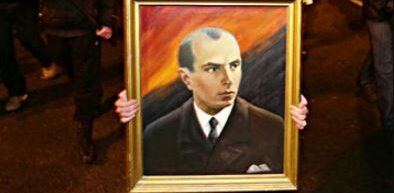The Agony of Ukraine
Momentous events in Ukraine from late 2013 to the present provide the backdrop to this article.
The Maidan (Independence Square) in Ukraine’s capital of Kiev was center stage for the “revolution.” Because the protests at the Maidan demanded Ukraine’s integration into the European Union (EU), the revolt became known as the “Euromaidan.”
President Yanukovych tried to suppress the movement, but government violence was met with resistance; dissent moved from peaceful protest to violent revolution, the collapse of the Yanukovych regime and the creation of a pro-Western interim government.
The Russian-speaking population of south and east Ukraine opposes the new regime; Crimea was annexed into the Russian Federation, and the U.S. and EU slammed Russia with sanctions. At the time of this writing, with a civil war unfolding, a new oligarch was elected by western Ukrainians, but voting in the south and east of the country was disrupted or boycotted. A day after the election, Kiev launched jet attacks against pro-Russian separatists in eastern Ukraine, likely killing up to 100. All of this and more is driving the region towards war.
Stepping into the quagmire stoked by super power geo-strategic interests, are a number of artists, arts organizations, and arts publications, some of which I will criticize in this article. Oddly enough, none of the artists or artworks mentioned in this article present a cogent reason for exactly why Ukraine’s integration into the EU would result in a more prosperous and democratic Ukraine. This is especially interesting since millions of people from Spain to Greece have been demonstrating in opposition to the tough austerity measures of the EU.
The influential publication ARTnews, ran a March 2014 article titled Icons on the Barricades: Incredible Ukrainian Protest Art, describing the role artists played in the uprising that overthrew President Yanukovych. Written by Ukrainian arts professionals Konstantin Akinsha (contributing editor for ARTnews), and Alisa Lozhkina (an art historian and curator in Kiev), the two touched upon a number of artistic interventions carried out during the uprising.
One was the claim that “anarchist artists” built a makeshift gallery near Kiev’s barricades during the revolt. From there the anarchists “exhibited works in the revolutionary spirit, such as an ironic image of Nestor Makhno, the legendary Ukrainian anarchist leader of the civil war period (1918–1921), along with anarchist slogans – ‘Freedom or Death’ – in combination with expletives. It was a popular spot with both artists and protesters.”
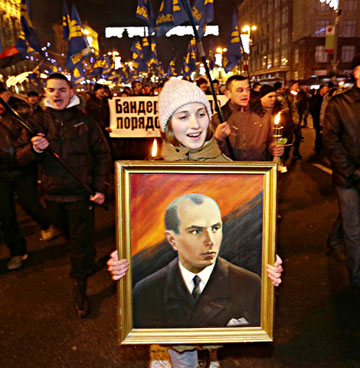
ARTnews might point to a lone painting of the anarchist Nestor Makhno (1919-1921) glimpsed in an improvised street gallery, but the portrait most often seen during the Euromaidan protests was that of WWII-era Ukrainian ultranationalist and fascist Stepan Bandera (1909-1959). It is not likely that the authors of the article were unaware of that fact. Knowing Bandera’s history and legacy is key to understanding a powerful faction of Ukraine’s present-day ultranationalists.
In the 1930s Bandera and his followers wanted to create a state based on “pure” Ukrainian ethnicity; the “Banderists” regarded Poles, Jews, and Russians as oppressors to be purged from the motherland.
Bandera and his Ukrainian Insurgent Army (UPA) formed an active alliance with the Third Reich in order to establish an “independent” Ukraine. In Feb. 1941 the Nazis created two military units comprised of Ukrainian volunteers, the Nightingale and Roland Battalions.
Armed, trained, and financed by the Nazis, the battalions were under the command of Nazi special forces but operated under the orders of Stepan Bandera. In 1943 Bandera’s UPA soldiers conducted a vicious pogrom against Jewish, Polish, and Russian minorities in Ukraine, murdering some 90,000 civilians. In 1959 Bandera was assassinated by the Soviet KGB.
A handful of anarchists might have presented artworks on the street during the unrest, but ARTnews failed to report that groups on the left were forcefully disallowed a political role in the uprising by Banderist thugs who repeatedly and violently attacked them during the rebellion.
There were no black anarchist flags flying over Maidan, but there were plenty of banners from Banderist groups, including the red and black pennants of Bandera’s UPA. To Ukrainian ultra-nationalists, red and black symbolize the people’s “blood and soil,” that concept might sound familiar to students of history.
ARTnews also wrote that “when the demonstrations began, a statue of Lenin on Shevchenko Boulevard was toppled by protesters,” an act described in the article as overthrowing “the symbol of a vanished ideology.”
ARTnews did not report that Lenin’s statue was actually pulled down and destroyed by members of the extreme ultra-nationalist Svoboda party, or that the pedestal where the statue once stood was spray painted with the slogan, “Bandera – 105,” a reference to 2014 being the 105th birthday anniversary of Stepan Bandera. My pointing this out is not a defense of Lenin or the Soviets in Ukraine.
Igor Miroshnichenko of Svoboda told the press that his group was responsible for destroying the Lenin statue. This is the same Miroshnichenko that had himself filmed as he physically assaulted the top executive of a Kiev TV station. The xenophobic Miroshnichenko forced the CEO to sign a resignation letter because Svoboda did not like the station’s reporting. Now a Member of Parliament representing Svoboda, Miroshnichenko sits on the new government’s “committee on freedom of speech.”
Svoboda (“Freedom”) is one of Ukraine’s largest ultranationalist political parties. During the Maidan protests the group’s flag was highly visible; the banner displays the national colors of blue and yellow and is emblazoned with a hand giving a three fingered salute approximating a trident, the national symbol of Ukraine.
The organization is currently led by Oleh Tyahnybok. In an article titled, Svoboda: The rise of Ukraine’s ultra-nationalists, the BBC reported that in 2004 Tyahnybok gave a televised speech in which he exhorted Ukrainians to combat the “Muscovite-Jewish mafia that runs Ukraine today.” In 2005 he signed an open letter calling upon the Ukraine government to fight the “criminal activities of organized Jewry.” In 2013 the World Jewish Congress asked European governments to consider banning neo-Nazi parties like Svoboda.
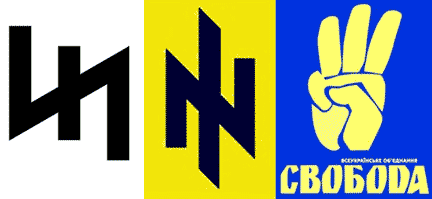
But Svoboda sprang from an earlier party, the Social-National Party of Ukraine (SNPU). Founded in 1991 by Andriy Parubiy and Oleh Tyahnybok, the SNPU modeled itself after Hitler’s “National Socialist” party, taking the Nazi “Wolfsangel” heraldic symbol as their logo. In 1998 the SNPU formed a paramilitary, the Patriots of Ukraine, led by Parubiy. In 2004 the SNPU reformed its image by phasing out its Nazi inspired logo and changing its name to Svoboda.

The ARTnews article went on to mention that “the most popular artworks inspired by Maidan were the performances,” and pointed to musician Mariyan Mitsik as a prime example. Mitsik performed in the streets at a piano he painted in yellow and blue, the colors of the EU and Ukrainian flags.
He performed Chopin, was well as Imagine by John Lennon. According to ARTnews, he performed “in front of the line of police guarding the presidential administration building,” and that his playing Chopin in front of “helmeted policemen in anti-riot gear became an icon of the protests.”

In an interview with the BBC, Mitsik stated that the performance demonstrated “the spirit of the revolution, that it’s actually peaceful, and it’s cultural, we are actually trying to change the situation in a peaceful way.” But there were other painted pianos in the streets for people to play, and a black-clad Svoboda party street fighter wearing a ski-mask and body armor took to entertaining the crowds with his piano virtuosity.
One could just as easily say the fascist street fighter’s performances were “an icon of the protests.” As of this writing, there are certainly more videos of the Svoboda pianist on YouTube than there are of Mitsik… and they have more viewers as well. The Svoboda party even filmed their militant pianist performing on the street!
Before the Maidan protests, the European Parliament passed a resolution on Dec. 13, 2012 regarding the situation in Ukraine.
In point number 8 of the resolution, it was stated that the European Parliament: “is concerned about the rising nationalistic sentiment in Ukraine, expressed in support for the Svoboda Party, which, as a result, is one of the two new parties to enter the Verkhovna Rada (editor’s note: Ukraine’s legislature); recalls that racist, anti-Semitic and xenophobic views go against the EU’s fundamental values and principles and therefore appeals to pro-democratic parties in the Verkhovna Rada not to associate with, endorse or form coalitions with this party.”
By not mentioning the existence of Svoboda and other ultranationalist extremist groups, ARTnews published a whitewash of events in Ukraine, but they were not the only ones to do so. However, if ARTnews actually favored democratic governance in Ukraine, they would have exposed the openly fascist elements that participated in the Maidan protests. There is no middle-ground here, the ARTnews article shows either willful ignorance of a complex political situation, or open support for ultranationalism.
On April 27, 2014 hundreds of young Ukrainians that consider Stepan Bandera a hero participated in a march in the western Ukrainian city of Lviv. It was a rally that celebrated the 1943 formation of the SS Galician Division (“Galicia” being an old name for the western most part of Ukraine). The division of some 81,000 soldiers was made up of Ukrainian volunteers and organized, armed, and trained by the Nazi Waffen SS. ARTnews did not mention a word of the 2014 march, nor did they point out that thousands of activists who uphold Bandera’s political philosophy made up a significant portion of the Maidan protest.
During Germany’s November 2013 memorial observation of “Kristallnacht,” 120 retail stores in Berlin placed enormous stickers simulating broken glass in their shop windows; solemn reminders of the violent anti-Jewish pogroms the Nazis unleashed when they destroyed Jewish homes, property, and 267 synagogues throughout Germany on Nov. 9, 1938.
The sticker campaign was in conjunction with the exhibition, Diversity Destroyed: Berlin 1933-1938, at the German History Museum in Berlin. German anti-fascist activists and arts professionals succeeded in mounting a creative and appropriate memorial to the horrors of fascism. In contrast, by ignoring how some Ukrainians collaborated with the Nazis, and how those collaborators are upheld as heroes by some contemporary Ukraine nationalists now shaping events in the country, ARTnews is in danger of putting itself on the wrong side of history.
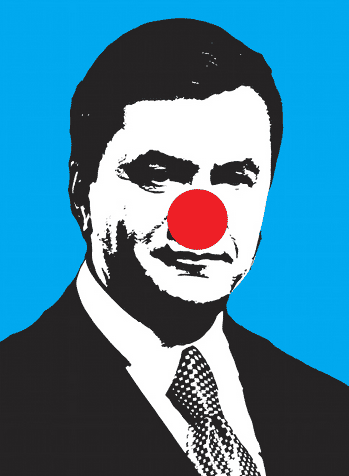
An exhibit titled I Am A Drop In The Ocean: Art of the Ukrainian Revolution, has also garnered support from the art world and the press. According to the exhibit’s press release, the show presents “original art works, photo and video material and objects used by the protesting Maidan defenders.” Curated by the aforementioned Konstantin Akinsha of ARTnews, the exhibit is on view at the Künstlerhaus cultural center in Vienna, Austria from April to May, 2014.
The exhibit presents documentation of performance works that took place on the streets during the Maidan revolt; that section of the show is titled The Ghost of Guy Debord. The press release for the exhibit states that “this Ukrainian version of Situationism proved to be extremely effective propaganda art, that could gain mass support and provoke mass participation.”
But Guy Debord was a French Marxist theorist and a founding member of the anti-capitalist Situationist International (SI), which was active from 1957 to 1972. The artists and egalitarians of the SI unconditionally condemned nationalism and authoritarianism, so it is not difficult to imagine what they would say about Svoboda party extremists and other Ukrainian ultranationalists. If comparing the Situationists to the Maidan protest artists was not ridiculous enough, the exhibit reached new heights of absurdity with its section titled All Sans-culottes of Ukraine.
The “sans-culottes” were the radical masses of the French Revolution, poor laborers who hated the upper class. The storming of the Bastille prison was carried out by sans-culottes, who differentiated themselves from aristocrats by wearing long trousers instead of the fancy silk knee-breeches (culottes) favored by the rich – hence the name sans-culottes (“without culottes”).
Quoting from the exhibit’s press release; “The revolutionary crowds developed very quickly their own fashion. Plastic helmets – used for construction works or for sporting activities – provided protection against the rubber bullets of the police and became the Phrygian cap of the Ukrainian revolution. Especially helmets with ornamental decorations became the revolutionary chic. When the riots with the police escalated, the street fighters used almost everything to protect themselves, from expensive sport gear to medieval armor.”
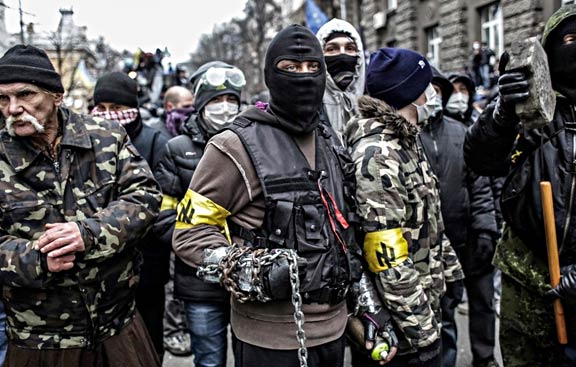
Revolutionary chic is not the issue the exhibit should be scrutinizing. The question should be, who were the street fighters and what were they fighting for? Pravy Sektor (“Right Sector”) was the organization that spear-headed the fighting; they served as an umbrella group for a number of like-minded organizations like the Ukrainian National Assembly/Ukrainian National Self Defense, Trident of Stepan Bandera, and the Patriots of Ukraine (who have an interesting recruitment video on YouTube). Trained, well organized, and ready to spark a right-wing “nationalist revolution,” these were the groups that conducted the fighting at Maidan.
Dmitry Yarosh is the leader of Right Sector, and he appears in a chilling video that details what the group fights for. The arts community should be especially interested to know that Right Sector boasts of fighting “Against degeneration and totalitarian liberalism.” On March 12, 2014, Newsweek conducted an interview with Yarosh, where he admitted that Right Sector militants “supported the first Chechen war against the Russian empire. We sent a delegation to Chechnya.”

The BBC’s flagship Newsnight program produced a short documentary titled, Neo-Nazi threat in the new Ukraine, in which BBC reporter Gabriel Gatehouse interviewed militants from the Right Sector. One young fanatic said the following when asked about the group’s political beliefs:
“I want there to be one nation, one people, one country. A clean nation. Not like under Hitler, but in our own way… a little bit like that.” The BBC film would have made an excellent video installation in the I Am A Drop In The Ocean exhibit, provided that curator Konstantin Akinsha had any honesty.
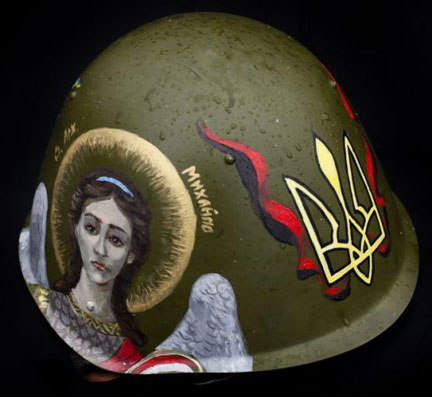
When writing about the “revolutionary crowds,” Akinsha did not mention Right Sector and its radical ultranationalist allies, but they were the ones to actually rain bricks and Molotov cocktails down upon the police. They fought hand to hand battles with the authorities using primitive weapons, and forcibly seized government buildings.
It was not a bunch of social democratic types seeking inclusion into the EU that waged the battles… it was the ultranationalists. The co-founder of the neo-Nazi Social-National Party of Ukraine, Andriy Parubiy, was the coordinator for the volunteer self-defense forces at Maidan. At the time of this writing he is now the head of Ukraine’s Defense Ministry, giving him control of the Ukraine Armed Forces.
I Am A Drop In The Ocean was also covered by The Art Newspaper, which quoted the exhibit’s curator as saying, “the exhibition will also feature objects from Maidan, including the catapult constructed by protesters to shell police. In a certain sense, we are equating these arms to art, which also became a weapon of the revolution.” Why would The Art Newspaper simply publish this ridiculous statement without challenging the curator?
The medieval style siege weapon that the exhibit’s curator compared to a work of art in actuality was a catapult used to hurl heavy stones and Molotov cocktails at police lines. The serious injuries resulting from its use are not hard to visualize; blunt trauma wounds, broken bones, and life threatening third degree burns come to mind.
Are there any other weapons of war The Art Newspaper would like to categorize as works of art? Perhaps the GBU-57 Massive Ordnance Penetrator would qualify. At 30,000-pounds and 30-feet-long, it is the biggest non-nuclear bomb in the US arsenal. While it does not have the rhythmical style of a medieval siege weapon like the catapult, the GBU still delivers the same blunt trauma wounds, broken bones, and life threatening third degree burns… only on a much larger scale.
No matter the cause behind the justification for using violence, or how dastardly the targets of that violence might be, celebrating the injury and mutilation of human beings has nothing to do with art, at least not in my book. The Künstlerhaus cultural center in Vienna should be ashamed to display the catapult as an art object. Unfortunately The Art Newspaper deleted their webpage covering the I Am A Drop In The Ocean exhibition.
The Artists Support Ukraine website initiative has garnered the most attention from the press and the arts blogosphere, though I can’t imagine why. International artists are encouraged to post their artworks and statements on the website in support of Ukraine and against “Russia’s aggression on the territory of independent Ukraine.” The project has received considerable attention, from articles in The Art Newspaper and the ostensibly liberal Huffington Post, to innumerable articles on arts oriented web logs.
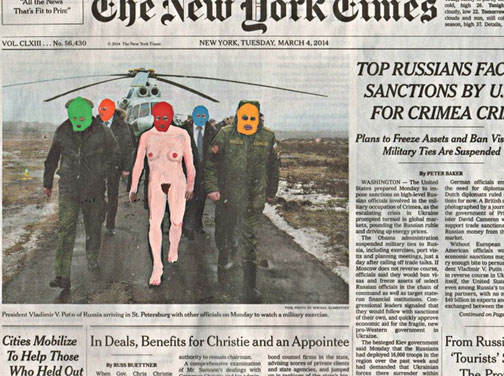
American artist Fred Tomaselli is amongst those who have lent their names and reputations to the cause championed by the Artists Support Ukraine website. In his collage uploaded to the website, Tomaselli painted Russian President Vladimir Putin and his bodyguards as members of the Russian Pussy Riot protest group. The central figure, Putin was painted as a naked female wearing a red mask. The collage was uploaded with the following artist’s statement:
“The world would be a better place if Putin wasn’t always trying to prove his ‘manliness.’ Of course, the USA had the same problem with Bush and look where that got him and us! I hope Ukraine can eventually achieve the ethical, open and equitable society it deserves. And I hope Putin gets his just desserts.”
While it is popular, and safe, for Americans to criticize Mr. Putin for “trying to prove his ‘manliness'” by way of his Ukraine policy, we should all know by now that wars are not fought to satiate the egos of national figureheads. Wars are fought for geo-political, economic, and strategic reasons, they are waged to secure resources and markets. This is true for Moscow as much as it is for Washington.
I wonder what Tomaselli thinks of President Obama’s global mass surveillance and drone war operations? Critical expressions regarding those offenses are not found in Tomaselli’s works. So much for the world being “a better place.”
A great deal of effort has gone into transforming Kiev into the “cultural heart of Ukraine.” It certainly has become a center for postmodern art. A 2012 article in the Financial Times titled State of the Art, reported that the billionaire steel magnate, Victor Pinchuk, opened Kiev’s PinchukArtCenter in 2006, where Ukrainians have been exposed to postmodern “greats” like Damien Hirst, Jeff Koons and Takashi Murakami. Forbes pegged Pinchuk as “Ukraine’s second-richest man, worth an estimated $3.2 billion.”
The Financial Times also wrote about “Ukraine’s first biennale of contemporary art,” which was held in 2012 before President Yanukovich was driven from office. FT reported that funding for the biennale, which cost some 4 million euros, came from government as well as the private sector. In addition FT reported that U.S. billionaire George Soros (who according to Forbes is the 27th richest person in the world with assets of $23 billion), funded Kiev’s Center for Contemporary Art (SCCA), which opened in 1993.
This mix of postmodernist artists and oligarchs is not a formula that leads to art and culture worthy of a new democracy. The same old postmodern art establishment, enamored with irony and disdainful of universal truths, sustained by extremely wealthy businessmen, and featuring the usual annoying international art stars, groans on in Kiev. Some of these charlatans now pretend to understand activist art. From Artforum’s account of the most current exhibit at the PinchukArtCenter, it can be deduced that the country did not just undergo a revolution.
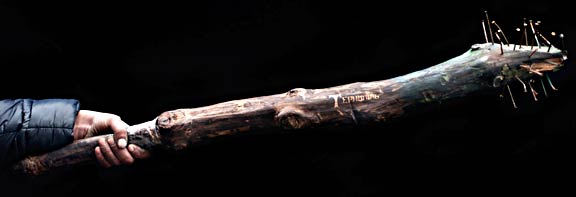
Attending the opening of the exhibit in question, Fear and Hope, which supposedly “addresses recent political activity in the region,” was Graham Tiley, the Shell Oil Company Ukraine County Chair and General Manager of Shell Ukraine Exploration and Production company. Also present at the opening was Masha Tsukanova, the editor in chief of the newly launched Vogue Ukraine.
Perhaps Masha regaled attendees with some authentic sans-culottes revolutionary chic, replete with a Right Sector hardhat and her own nail-studded club. Possibly the only one absent from the gathering was Hunter Biden, the younger son of U.S. Vice President Joe Biden. I am sure Hunter’s nonattendance was excused, as he recently joined the board of directors of Burisma, a leading oil and natural gas production company in Ukraine.
The storm over Ukrainian nationalism vs. Russia has risen even higher into the upper echelons of the postmodern art establishment, bringing the hullabaloo to Manifesta, the nomadic European biennial of contemporary art. Funded by the EU, Manifesta changes its host country every two years, and this year Manifesta 10 is slated to be held from June 31 to October 2014, at The State Hermitage Museum in the City of St. Petersburg, Russia.
The renowned German curator, Kasper König, was selected as the biennial’s curator. Professor König noted that Manifesta 10 “will complement the Hermitage’s 250th anniversary while celebrating its own 20th anniversary.”
The Hermitage is home to one of the greatest art collections in the world, and I would love to see how König mixes its classical collection with contemporary works, but others would rather have Manifesta 10 not happen at all.
Change.org, the “progressive” website that provides a platform for petitions meant to “empower people everywhere,” is hosting a petition written by an unidentified group of artists from Amsterdam and Düsseldorf. The petition, Suspend Manifesta 10 in St. Petersburg until Russian troops are withdrawn from Ukraine, states that “participation in cultural activities with Russia at this time means legitimization and acceptance of Russian aggression towards the democratic nation of Ukraine.” At the time of this article the petition has received 1,900 signatures.
On March 11, 2014, the Manifesta 10 Foundation responded to the calls for a boycott by stating that the foundation “remains committed to continuing with the Biennial in St. Petersburg.” Moreover, the foundation made it clear that “We believe canceling the project plays directly into the current escalation of the ‘cold war’ rhetoric and fails to acknowledge the complexity of these geo-politics.” Soon after Professor König offered the follow remarks:
“In response to the comments I have received regarding the current geopolitical circumstances, I would like to stress that obviously I am very concerned with the escalating crisis, and because of it I do believe it is and should be our goal to continue to make MANIFESTA 10 happen. It is itself a complex entity, to prompt its artists and its viewers to assume their own strong political positions, to pose questions and raise voices. To neglect and quit, would be a sign of escalation.
There is vulnerability of this situation, but also a challenge and we shall have a courage to go on, a decision backed up by many Russian colleagues. It is upon us not to be influenced by prejudices against minorities or nationalist propaganda but to reject it. It is more important than ever to continue our work with courage and conviction for the local and international publics. As someone who has worked in many and various political climates and challenges, the experience tells me to stay calm and continue to work on the complexity and contradiction, that art has to offer and on how it can engage, and oppose the simplifications of our times.”
On the Artists Support Ukraine website, a polemic attack against Professor König was uploaded by the Civic Forum for Contemporary Art (CFFCA) of Warsaw, Poland. The CFFCA condemned König, writing that his remarks were “supportive of the aggressive policies of Vladimir Putin,” and that they resembled “a declaration of loyalty to the Russian President, government, and parliament.” The CFFCA’s diatribe against König did however end with a truism: “Culture cannot let itself be taken hostage by regimes; it needs to retain real freedom.” Perhaps the CFFCA should contemplate the deeper meaning of that statement.
The aforementioned articles and exhibits, the calls to shut down MANIFESTA 10, and the invective launched against curator Kasper König, are part and parcel of a new Cold War that has grown out of the Ukraine crisis. Knowingly or unwittingly, some arts professionals are fueling the fires of ultranationalism and a new Cold War. I do not often agree with The Nation Magazine, that flagship publication of America’s progressive left, but the journal addressed this tension between nations with their May 2014 editorial, Cold War Against Russia – Without Debate, which in part reads:
“Future historians will note that in April 2014, nearly a quarter-century after the end of the Soviet Union, the White House declared a new Cold War on Russia – and that, in a grave failure of representative democracy, there was scarcely a public word of debate, much less opposition, from the American political or media establishment.
(….) No modern precedent exists for the shameful complicity of the American political-media elite at this fateful turning point. Considerable congressional and mainstream media debate, even protest, were voiced, for example, during the run-up to the US wars in Vietnam and Iraq and, more recently, proposed wars against Iran and Syria.
This Cold War – its epicenter on Russia’s borders; undertaken amid inflammatory American, Russian and Ukrainian media misinformation; and unfolding without the stabilizing practices that prevented disasters during the preceding Cold War – may be even more perilous. It will almost certainly result in a new nuclear arms race, a prospect made worse by Obama’s provocative public assertion that ‘our conventional forces are significantly superior to the Russians,’ and possibly an actual war with Russia triggered by Ukraine’s looming civil war.”
As I was finishing up writing this article, I read the news that former U.S. Secretary of State, Madeleine Albright, was in Kiev with a team of U.S. observers to supervise Ukraine’s May 25 elections. If ever there was to be an indication of a society facing imminent destruction, it would be a visit from Ms. Albright.
As President Clinton’s U.S. Ambassador to the UN (1993-1997), Albright defended sanctions against Iraq in a May 12, 1996 interview conducted by Lesley Stahl on the CBS 60 Minutes broadcast. Stahl asked Albright, “We have heard that half a million children have died. I mean, that’s more children than died in Hiroshima. And, you know, is the price worth it?” Albright answered, “We think the price is worth it.” One should recall, as President Clinton’s Secretary of State (1997-2001), Albright played a significant role in advancing the U.S./NATO bombing of Serbia during the Kosovo war.

During the Maidan uprising, Ukrainians demonstrated against the rule of oligarchs; they demanded democratic governance and an end to corruption. They ended up electing an oligarch as president, with their nation not only divided, but spinning into the orbit of the EU, NATO, and the asset-stripping International Monetary Fund (IMF).
The unlikely new president, Mr. Poroshenko, is the owner of the Ukraine-based Roshen Confectionary Corporation, one of the largest candy makers in the world. Hailed by the press as the “Chocolate King,” Poroshenko is worth around $1.3 billion. Somewhere in this ongoing drama there are millions of decent Ukrainians who want neither a neo-fascist state, a phony liberal one run by oligarchs, or subjugation by Russian rulers. The question now, is whether they can make their presence felt.
— // —
UPDATE: Jan. 2, 2015: On the evening of January 1, 2015, up to 5,000 neo-fascists held a torchlight march in Kiev to honor Stepan Bandera on what would have been his 106th birthday. It must be remembered that on June 30, 1941, Nazi soldiers occupied Ukraine, and Bandera took the occasion to declare an Independent Ukrainian state. In the proclamation of Ukrainian Statehood written by Bandera, it was clearly stated that:
“The newly formed Ukrainian state will work closely with the National-Socialist Greater Germany, under the leadership of its leader Adolf Hitler which is forming a new order in Europe and the world and is helping the Ukrainian People to free itself from Moscovite occupation.”
During the 2015 New Year’s commemoration for Bandera, marchers carried the red and black flag of his Ukrainian Insurgent Army while chanting “Bandera will return and restore order.” Marchers made their way to Kiev’s Independence Square (Maidan) to hear speeches from reactionary Svoboda party and Right Sector militants. You can see the march in videos from Reuters and RT.


